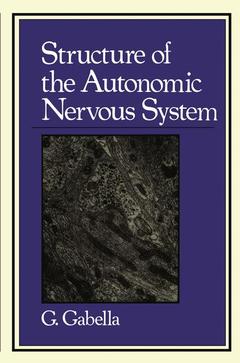Description
Structure of the Autonomic Nervous System, Softcover reprint of the original 1st ed. 1976
Author: Gabella G.
Language: English
Keywords
brain; growth; muscle; nervous system; neurology; neurons; spinal cord; sympathetic preganglionic neurons
Publication date: 10-2011
214 p. · 15.5x23.5 cm · Paperback
214 p. · 15.5x23.5 cm · Paperback
Description
/li>Contents
/li>
A conspicuous portion of the peripheral nervous system is part of the 'vegetative nervous system'; it includes all the neurons which innerv ate the viscera, salivary and lacrimal glands, the heart and blood vessels, all other smooth muscles of the body, notably the intrinsic muscles of the eye and the muscles of the hair. Only part of the system belongs to the peripheral nervous system: it has also its own nuclei and pathways in the central nervous system. The distinction between visceral and somatic functions is a very old one in our culture. With the development of neurology the notion of a widespread nervous control of body functions emerged. Winslow (1732) used the term nervi sympathici majores for those nerves, which he thought to carry about 'sympathies' and then co ordinate various viscera's functions. His was an anatomical break through, which obscured Willis' 'intercostal nerve' and Vesalius 'cranial nerve'. The notion was developed among others by John stone (1764) who arrived, with the aid of some very accurate anatomical observations, at the problem of the nervous influence on motion and sensitivity of viscera. By the end of the eighteenth century, it was clear, with Bichat (1800), that what he called 'sympa thetic nervous system' (and his pupil Reil, a few years later, 'vegeta tive nervous system ') controlled visceral functions (fa vie organique), whereas somatic functions (fa vie animafe) were under direct control from the brain and spinal cord.
1 The Autonomic Nervous System.- 1.1 Introduction.- 2 The Sympathetic Ganglia.- 2.1 The sympathetic ganglia.- 2.2 Ganglia of the sympathetic chain.- 2.3 Prevertebral ganglia.- 2.4 Chromaffin cells.- 2.5 Sympathetic ganglia in amphibians.- 2.6 Sympathetic ganglia in reptiles.- 2.7 Sympathetic ganglia in birds.- 2.8 Preganglionic fibres.- 2.9 Post-ganglionic fibres.- 2.10 Afferent fibres.- 3 The Adrenergic Fibres.- 3.1 The adrenergic fibres.- 3.2 Location of adrenergic endings.- 3.3 Structure of adrenergic endings.- 3.4 Release, uptake, synthesis and inactivation of the transmitter.- 3.5 Degeneration of adrenergic endings.- 4 The Sympathetic Ganglia in Development and Experimental Conditions.- 4.1 Development.- 4.2 Effects of nerve growth factor.- 4.3 Sympathectomy.- 4.4 Preganglionic denervation.- 4.5 Post-ganglionic denervation.- 4.6 Heterologous regeneration.- 4.7 Effects of denervation during development.- 4.8 Sympathetic ganglia in tissue culture.- 5 Paravisceral Ganglia.- 5.1 Ganglia and plexuses of the heart.- 5.2 The pelvic plexus.- 6 The Ciliary Ganglion.- 6.1 The ciliary ganglion in mammals.- 6.2 Other parasympathetic ganglia of the head.- 6.3 The ciliary ganglion in birds.- 6.4 Post-ganglionic fibres.- 6.5 Studies on development.- 6.6 Axotomy and other experiments on the ciliary ganglion.- 7 Intramural Ganglia.- 7.1 The intramural ganglia.- 7.2 Number and size of neurons.- 7.3 Cell types.- 7.4 Structure of neurons, nerve processes and glial cells.- 7.5 Nerve endings.- 7.6 The ‘post-ganglionic’ fibres.- 7.7 Studies on development.- 8 The Vagus Nerve.- 8.1 The vagus nerve.- 8.2 Structure of the vagus nerve.- 8.3 The nodose and jugular ganglia.- 8.4 Origin of the axons of the vagus nerve.- 8.5 The preganglionic neurons.- 8.6 Degeneration and regeneration of the vagus nerve.- 9 Autonomic Efferent Neurons in the Central Nervous System.- 9.1 Sympathetic preganglionic neurons.- 9.2 Sacral parasympathetic preganglionic neurons.- 10 Innervation of Organs.- 10.1 Eye.- 10.2 Salivary glands.- 10.3 Skin and appendages.- 10.4 Adipose tissue.- 10.5 Alimentary tract.- 10.6 Heart.- 10.7 Blood vessels.- 10.8 Spleen.- 10.9 Respiratory tract.- 10.10 Female genital tract.- 10.11 Male genital tract.- References.
© 2024 LAVOISIER S.A.S.




